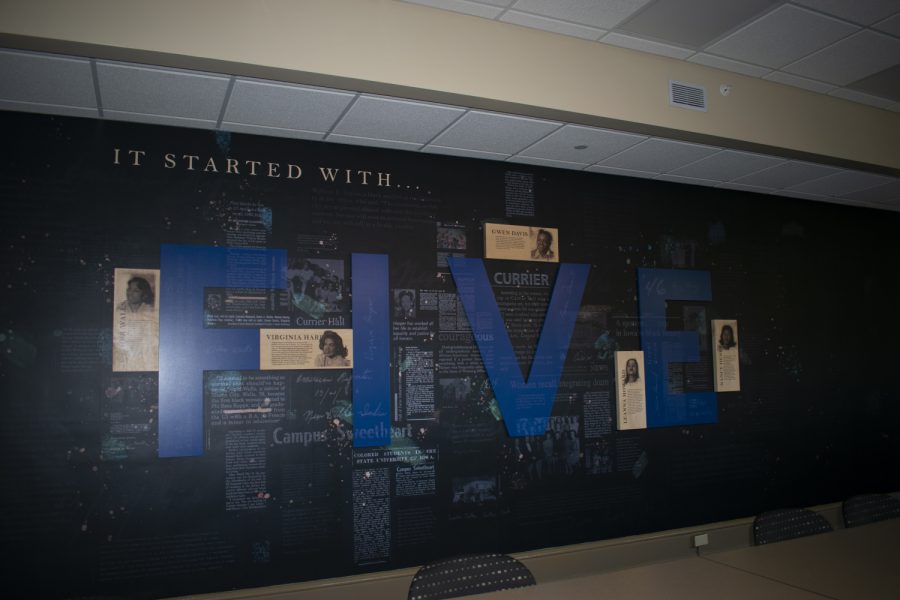New mural tells story of first five Black women to integrate UI residence halls
The new Currier Five Room mural showcases first five Black women to integrate Currier Hall in 1946.
The new mural in the University of Iowa’s Currier Residence Hall is seen on Sept. 2, 2021.
September 7, 2021
In fall 1946, Virginia Harper became one of the first non-white-passing Black women to integrate a University of Iowa residence hall. Now, an image of her face appears alongside the faces of four other women in a room in Currier Residence Hall — a room that 75 years ago, she was excluded from.
Following her time at the UI, Harper went on to spend five decades working with the Fort Madison branch of the NAACP, eventually becoming president in 1987 and serving until her death in 1997. She was the first Black woman on the State Board of Public Instruction — where she spearheaded the move for multicultural, nonsexist requirements in Iowa education — and the first Black woman appointed to the Iowa Board of Parole.
UI student and Currier Resident Assistant Spencer Owen said when he first pitched the idea for a Virginia Harper memorial room in Currier Hall, university staff members said they liked the idea, but wanted to expand upon it.
Owen’s original idea was to rename Currier’s North Lounge after Harper, but University Housing and Dining officials decided it was best to move the project to a more central location in the over 100-year old building, and broaden the proposal to encompass all five of the first non-white passing Black women to integrate the residence hall, known as the “Currier Five.”
In mid-August this year, the Currier “Green Room,” a popular study spot and conference room near the residence hall’s lobby, became the Currier Five Room.
The mural was created by Dubuque-based artists Adam and Dawn Eikamp. What was once a long stretch of bare, pale green wall — hence the former name, “Green Room” — now displays the faces of Gwen Davis, Virginia Harper, Nancy Henry, Leanna Howard, and Esther Walls.
These portraits are contiguous to blurbs from archived articles and photographs documenting the Five’s achievements and general history of Black students at the UI. Overlaying the mural reads, “It started with FIVE,” in bold letters.
The mural dives into the history and accomplishments of each woman. Walls went on to receive her B.A. in French, minored in education, and became the first Black woman at the university to be elected to the UI chapter of Phi Beta Kappa, the most prestigious undergraduate honors organization in the U.S.
Davis moved on to conduct research for NASA and worked as a science teacher for the New York City public school district.
Howard joined the U.S. Air Force and earned the National Defense Service Medal and Good Conduct Medal.
Henry advanced to study education in graduate school, and taught at Southeast High School in Kansas City for 44 years before retiring.
Owen said prior to the mural’s creation, mentions of the Currier Five were limited within the residence hall. Outside of his own independent research, what he knew about the Five came from a small portion of a historical gallery in Currier’s common area.
Oddly enough, he noted, the area held more space for the story of students doing laundry for the first time than it did the Currier Five.
“The university didn’t talk about the Currier Five a lot. Other than like occasional articles that pop up here and there, [conversations] are always student-led,” Owen said. “…It’s very important to have that contextualization in these buildings, because it is an act of disservice to not talk about them — which is kind of the approach the university took, whether that be intentionally or unintentionally.”
Owen recalled the various documents he found during his research that showed the ways in which the Currier Five and other Black students were discriminated by the university, including a 1935 statement from then-UI Dean of Men Robert Rienow stating that it would be “quite impossible to permit Negro students to live in our Quadrangle,” because of a “very distinct social line.”
Owen described UI housing as being “unofficially, but officially” segregated until 1946. Black students were refused service and acknowledgment at local restaurants and campus facilities, like the Iowa Memorial Union. Before integration, Black students were housed by Black Iowa City residents, as it was a legal and common occurrence for landlords to deny Black students occupancy.
Additionally, the university’s chapter of the Black fraternity Kappa Alpha Psi — which still exists now — was outbid for a site for their chapter house by a local chapter of the KKK.
Owen added that the integration of Currier Residence Hall in 1946 was not a change done by white administrators, but one done by Black students and non-Black allies “pulling teeth and nails and getting the university to do something.”
“When the university wasn’t providing for its students, they found they had to support themselves,” Owen said. “And we had students who were actively harmed by the university’s practices at the time. I mean, that same dialogue continues to come up now of minority students being actively harmed by university practices. And even if things weren’t intentional, there’s still harm that was done and harm that needs to be remedied, and why this is by no means a remedy — it’s keeping that conversation going.”
Creators of the Currier Five mural, Dawn and Adam Eikamp, have considerable experience installing art in UI residence halls. Since the beginning of their residence hall-art expedition at Petersen Hall in 2015, the two have gone on to create pieces for Catlett, Daum, and most recently, Burge and Currier.
Their recent mural in Burge showcases the biographies and faces of the UI’s first female educators at the University of Iowa. They also created the Elizabeth Catlett mural on display in Catlett Hall, which takes viewers through the timeline of her life. Catlett was the first African American and woman to graduate from the UI with a Master’s in Fine Arts. The Petersen mural, “Scholastic Truth,” is an abstract sculpture representing different influences of students through college life.
Adam Eikamp said while his wife takes on more of the design and big-picture side of things, he often drives the research angle of their assignments.
“I mean, when you dive into these projects you pretty much immerse yourself in it — you’re taking a full bath in the river when you’re diving into as much as you possibly can about them,” Adam said. “It gets a little intimidating. Overall, I think we did a pretty good job, but I am still nervous about a delicate conversation.”
Adam said the two tried to make the mural as factual and unbiased as possible. When piecing together the mural, they elected to include the racist rhetoric used in the original newspaper clippings.
“You can’t rewrite the history of the article, but is that appropriate to include in this modern zero?” Adam said. “And you include it because that’s what it was. It’s not right, but you gotta understand what those times were. Were those times right? Of course not.”
Von Stange, assistant vice president for student life and senior director of University Housing and Dining, said the university has plans to incorporate more historically driven art in Hillcrest, Rienow, and Slater Residence Halls as they go through upcoming renovations.
Stange said he hopes the Currier Five mural will help UI students understand who their flag bearers were, and the choices the Five made in order to be the first ones to live on campus.
He added that he hopes the students view the mural with a sense of pride, and question why it didn’t come sooner.
“I think that is a history that we want to be able to share, because that’s a history probably at the university that’s not readily acknowledged and, frankly, from personal perspective, something that we’re not particularly proud of either,” Stange said.





